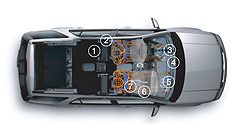News Center
News CenterA Safety System that Senses Its Passengers
To help protect driver and passenger in the event of a crash, our new safety technologies enhance the performance of safety belts and airbags and provide additional occupant protection in side crashes and rollovers.

Personal Safety
The Ford Personal Safety System® helps reduce the risk of injury to the driver and right-front passenger in the event of a moderate to severe frontal collision. The system is designed to adjust the deployment of the front airbags to enhance protection for front-seat occupants. It does this with the help of technologies such as crash severity sensors, safety belt usage sensors, dual-stage driver and front-passenger airbags, a driver's seat position sensor and front outboard safety belt pretensioners.
The Personal Safety System® is standard on many Ford vehicles in the United States.
Side-Impact Airbags
Side-impact air bags for the driver and right-front passenger further enhance chest-area protection and are standard on most models. New door armrests and door trim also provide additional abdomen and lower torso cushion, and a four-inch-thick foam block inside each door helps to manage side-impact forces on the occupants' hips.
Intelligent Safety SystemTM
Building on Ford's Personal Safety System, our Intelligent Safety System on Explorer and Mountaineer uses information from sophisticated vehicle sensors to determine crash severity, occupant size, position and safety belt status.
In the event of a frontal crash, a variety of technologies work to engage innovative safety features to help protect the driver and front passenger in milliseconds:
- Seat Track Position Sensor—Driver seat position is monitored to determine inflator output and steering column energy absorption level.
- Adaptive Load-Limiting Retractors—Adaptive load-limiting retractors provide multiple levels of restraining force to help tailor the safety belt response to the specific needs of each occupant.
- Adaptive Steering Column—Steering column design provides two levels of energy absorption.
- Adaptive Airbag Inflation—Additional levels of airbag inflation are provided by incorporating a variable time delay between the 1st and 2nd stage output.
- Adaptive Airbag Venting—When activated, this unique safety feature diverts gas away from the airbag, offering occupants less powerful airbags when required.
- Enhanced Occupant Classification System—A front passenger seat sensor identifies the following five stages of occupant classification: empty seat, child presence, small adult presence, medium adult presence and large adult presence.
- Adaptive Airbag Tethers—Through deployment of airbag tethers, airbag shape and size is controlled to match the specific needs of each occupant.
Related
-
Ford and World Safety Leaders Work to Launch Intelligent Vehicles Quicker, More Affordably
-
Ford Wins Progressive Manufacturing Operational Excellence Award for Wireless Software Installation on the Assembly Line
-
Ford Develops Heart Rate Monitoring Seat; Adds New Element to Health and Wellness Research
-
Touting Our Own Horns: Humble Honker Far More Than Just a Beep or Blast at Ford







Connect With Ford
Ford Motor Company on Facebook
Ford Motor Company on YouTube
Follow @Ford on Twitter
Ford Motor Company on Flickr